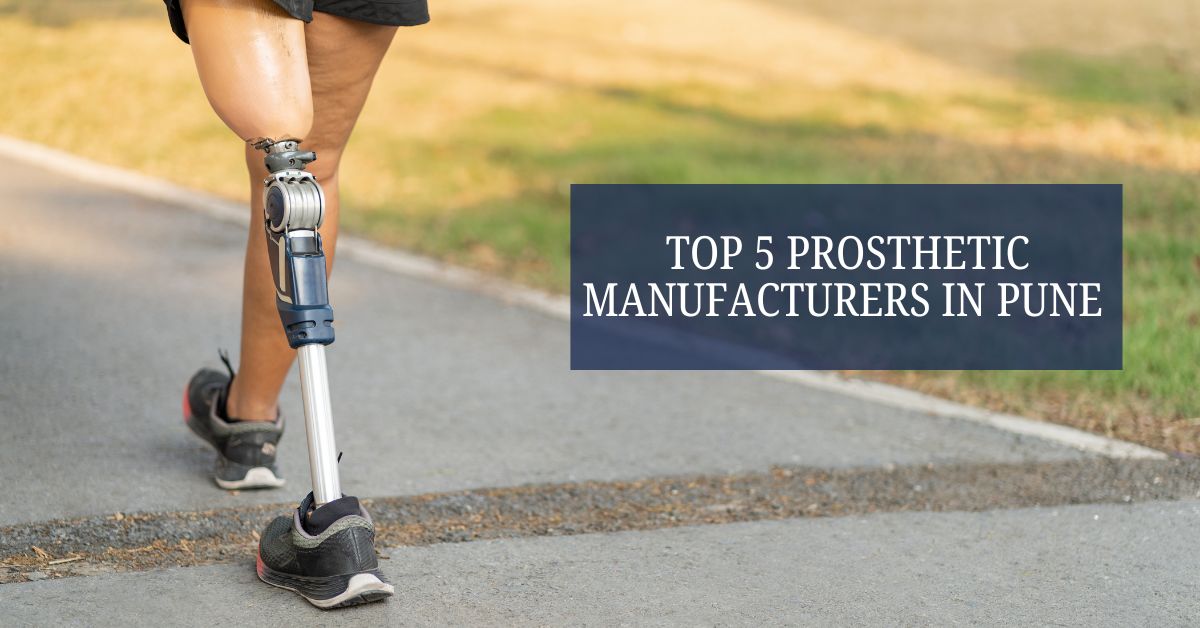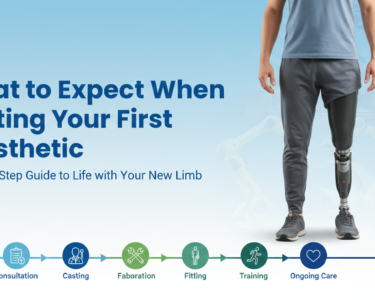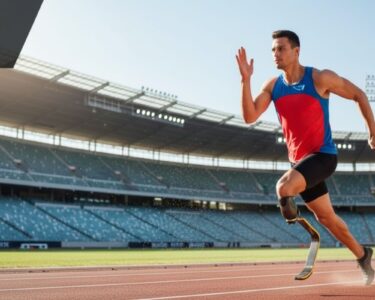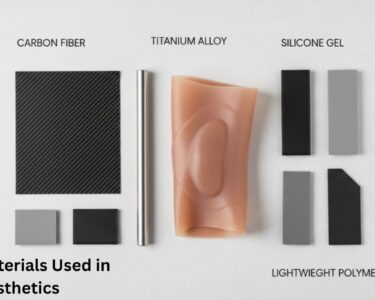Losing a limb can be life-changing, but advancements in prosthetic technology have made it possible for individuals to regain mobility and independence. India has emerged as a global hub for high-quality and affordable artificial limbs, with several manufacturers leading the way in innovation, comfort, and durability. Whether it’s a basic prosthetic for daily use or an advanced bionic limb with cutting-edge features, these companies are revolutionizing the field of prosthetics. In this articl
Losing a limb can be life-changing, but advancements in prosthetic technology have made it possible for individuals to regain mobility and independence. India has emerged as a global hub for high-quality and affordable artificial limbs, with several manufacturers leading the way in innovation, comfort, and durability. Whether it’s a basic prosthetic for daily use or an advanced bionic limb with cutting-edge features, these companies are revolutionizing the field of prosthetics. In this article, we explore the top 5 artificial limb manufacturers in India in 2025, highlighting their contributions to improving lives and redefining possibilities for amputees.
What Is an Artificial Limb?
An artificial limb, also known as a prosthetic limb, is a device designed to replace a missing arm, leg, hand, or foot, allowing individuals to regain mobility, independence, and a better quality of life. Amputation may occur due to injury, illness, infection, or congenital conditions, making prosthetics essential for restoring movement and function.
Modern prosthetics are designed to be lightweight, durable, and as natural as possible in appearance and movement. With technological advancements, artificial limbs have evolved from basic wooden or metal structures to high-tech prosthetics made of carbon fiber, titanium, and silicone, offering improved flexibility and control.
Artificial limbs are customized based on an individual’s needs, lifestyle, and level of amputation. Some prosthetics focus on basic mobility, while others, such as bionic limbs, use electronic sensors and microprocessors to mimic natural movement.
A well-fitted prosthetic limb can significantly enhance daily activities, allowing users to walk, run, lift objects, or even perform complex tasks like typing or sports activities. Many prosthetic users work closely with prosthetists (specialists who design and fit artificial limbs) to ensure the best fit and comfort.
What Are the Different Types of Artificial Limbs?
Artificial limbs come in different types, each designed to serve a specific purpose based on the level of amputation and the needs of the user. These prosthetic limbs help individuals regain mobility, independence, and function in daily life. The four main types of artificial limbs include:
1. Prosthetic Legs (Lower Limb Prosthetics)
Lower limb prosthetics are used for people who have lost a leg due to amputation. These are further categorized as:
- Below-Knee Prosthesis (Transtibial Prosthesis): Replaces the lower part of the leg while preserving the knee joint. It allows for easier movement and mobility.
- Above-Knee Prosthesis (Transfemoral Prosthesis): Replaces the leg above the knee, requiring a knee joint in the prosthetic to enable walking.
Modern prosthetic legs can include hydraulic or microprocessor-controlled knee joints that provide more natural movement. Some are even designed for running and sports activities.
2. Prosthetic Arms (Upper Limb Prosthetics)
Upper limb prosthetics replace a missing arm, forearm, hand, or fingers. These can be:
- Below-Elbow Prosthesis (Transradial Prosthesis): Attaches below the elbow, providing hand function.
- Above-Elbow Prosthesis (Transhumeral Prosthesis): Includes an elbow joint for more complex arm movements.
Advanced prosthetic arms, such as myoelectric arms, use muscle signals to control movement, allowing users to grip objects, type, or even play musical instruments.
3. Functional or Mechanical Prosthetics
These are basic prosthetics designed for strength and durability rather than fine movements. They are commonly used for physical labor or sports and rely on body movements or straps to control them.
4. Cosmetic Prosthetics
Some people prefer prosthetic limbs that look more natural and lifelike rather than being highly functional. These prosthetics are made from silicone or other materials that resemble real skin and are often custom-designed to match the person’s skin tone and appearance.
Each type of artificial limb is designed based on a person’s needs, lifestyle, and level of activity. Advancements in technology continue to improve the comfort, durability, and performance of prosthetic limbs, helping individuals lead more independent and fulfilling lives.
1. Proactive Technical Orthopaedics Pvt Ltd
Based in Pune, Proactive Technical Orthopaedics Pvt Ltd is a leading name in the manufacturing and supply of high-quality prosthetic and orthopedic components in India. Recognized for their innovation and precision, they specialize in advanced orthotic solutions designed to enhance patient mobility and improve hospital outcomes.
Their expertise extends beyond prosthetics, incorporating automation-driven manufacturing to produce essential orthopedic machinery and components. By blending state-of-the-art technology with skilled craftsmanship, Proactive technical orthopaedics ensures that each product meets the highest standards of durability, comfort, and functionality.
With a strong focus on innovation, quality, and patient-centric solutions, Proactive Technical Orthopaedics Pvt Ltd continues to make a global impact in prosthetics and orthotics, improving lives and redefining mobility solutions worldwide.
2. Artificial Limbs Manufacturing Corporation of India (ALIMCO)
The Artificial Limbs Manufacturing Corporation of India (ALIMCO) is a government-owned enterprise operating under the Ministry of Social Justice & Empowerment, Department of Empowerment of Persons with Disabilities. As a Miniratna Category II public sector unit, ALIMCO is dedicated to producing high-quality rehabilitation aids and assistive devices for individuals with disabilities.
Unlike commercial manufacturers, ALIMCO prioritizes accessibility and affordability, ensuring that prosthetic and orthotic solutions reach underserved communities across India. The corporation actively supports the Pradhanmantri Divyasha Kendra (PMDK) initiative, working with national institutes and regional centers to expand the reach of the ADIP scheme.
As the only manufacturer in India offering a comprehensive range of assistive devices under one roof, ALIMCO is committed to social responsibility, innovation, and quality. Their efforts empower individuals with disabilities by providing reliable mobility solutions, helping them lead independent and fulfilling lives.
3. Ottobock India
Ottobock India, a subsidiary of the globally renowned Ottobock, is a leader in prosthetic, orthotic, and mobility solutions. With a mission to enhance the quality of life for individuals with disabilities, Ottobock India provides state-of-the-art prosthetic limbs, orthotic supports, mobility aids, and rehabilitation services tailored to a variety of patient needs.
What sets Ottobock apart is its commitment to cutting-edge technology and personalized patient care. By working closely with healthcare professionals, they ensure that every device is customized for maximum comfort, durability, and functionality. Their continuous research and development efforts keep them at the forefront of prosthetic advancements.
With a wide network of service centers across India, Ottobock India ensures easy access to high-quality mobility solutions. Additionally, they conduct educational workshops and awareness programs to promote disability inclusion. Through innovation, accessibility, and a patient-first approach, Ottobock India empowers individuals with disabilities to lead more active and independent lives.
4. KARE Prosthetic & Orthotic Bangalore
KARE Prosthetic & Orthotic Bangalore is a leading provider of customized prosthetic and orthotic solutions, offering a range of prosthetic limbs, orthotic braces, supports, and mobility aids tailored to individual needs. The company is dedicated to improving the quality of life for people with limb loss and orthopedic conditions through advanced technology and personalized care.
With a patient-first approach, KARE ensures that each device is meticulously designed for optimal fit, comfort, and functionality. Their team of experienced professionals provides thorough assessments, personalized fittings, and ongoing rehabilitation support to help users adapt seamlessly to their prosthetic or orthotic devices.
Using cutting-edge materials and lightweight designs, KARE Prosthetics creates durable and comfortable solutions that enhance mobility and independence. Their commitment to innovation, quality, and patient care makes them one of India’s most trusted names in the prosthetics and orthotics industry.
5. PL-Prosthetic India Private Limited
PL-Prosthetic India Private Limited is a renowned manufacturer of advanced prosthetic and orthotic solutions, committed to enhancing mobility and improving the lives of individuals with limb loss and orthopedic conditions. The company specializes in lightweight, durable, and high-performance prosthetics designed for comfort and functionality.
Their product portfolio includes prosthetic limbs, orthotic braces, and mobility aids, all tailored to the specific needs of each user. PL-Prosthetic India prioritizes affordability, ensuring that high-quality prosthetic solutions are accessible to a broader population, including those in underserved areas.
With a team of dedicated professionals, the company provides comprehensive services—from initial assessment and fitting to continuous rehabilitation support. By combining innovation, precision, and a strong commitment to customer satisfaction, PL-Prosthetic India has established itself as a trusted leader in the prosthetics and orthotics sector. Their efforts are continuously geared toward improving independence, mobility, and overall quality of life for individuals with disabilities.
Empowering Mobility and Independence
India’s top artificial limb manufacturers are revolutionizing the prosthetics and orthotics industry with cutting-edge technology, innovation, and patient-centric solutions. Companies like Proactive Technical Orthopaedics Pvt Ltd, Ottobock India, and KARE Prosthetics & Orthotics are redefining mobility with advanced, customized devices, while ALIMCO continues to make prosthetic solutions accessible to all. Their dedication to quality, comfort, and functionality ensures that individuals with disabilities can regain independence and lead fulfilling lives. As the industry continues to evolve, these manufacturers remain at the forefront, driving progress and inclusivity in the field of assistive technology.
e, we explore the top 5 artificial limb manufacturers in Mumbai in 2025, highlighting their contributions to improving lives and redefining possibilities for amputees.
What Is an Artificial Limb?
An artificial limb, also known as a prosthetic limb, is a device designed to replace a missing arm, leg, hand, or foot, allowing individuals to regain mobility, independence, and a better quality of life. Amputation may occur due to injury, illness, infection, or congenital conditions, making prosthetics essential for restoring movement and function.
Modern prosthetics are designed to be lightweight, durable, and as natural as possible in appearance and movement. With technological advancements, artificial limbs have evolved from basic wooden or metal structures to high-tech prosthetics made of carbon fiber, titanium, and silicone, offering improved flexibility and control.
Artificial limbs are customized based on an individual’s needs, lifestyle, and level of amputation. Some prosthetics focus on basic mobility, while others, such as bionic limbs, use electronic sensors and microprocessors to mimic natural movement.
A well-fitted prosthetic limb can significantly enhance daily activities, allowing users to walk, run, lift objects, or even perform complex tasks like typing or sports activities. Many prosthetic users work closely with prosthetists (specialists who design and fit artificial limbs) to ensure the best fit and comfort.
What Are the Different Types of Artificial Limbs?
Artificial limbs come in different types, each designed to serve a specific purpose based on the level of amputation and the needs of the user. These prosthetic limbs help individuals regain mobility, independence, and function in daily life. The four main types of artificial limbs include:
1. Prosthetic Legs (Lower Limb Prosthetics)
Lower limb prosthetics are used for people who have lost a leg due to amputation. These are further categorized as:
- Below-Knee Prosthesis (Transtibial Prosthesis): Replaces the lower part of the leg while preserving the knee joint. It allows for easier movement and mobility.
- Above-Knee Prosthesis (Transfemoral Prosthesis): Replaces the leg above the knee, requiring a knee joint in the prosthetic to enable walking.
Modern prosthetic legs can include hydraulic or microprocessor-controlled knee joints that provide more natural movement. Some are even designed for running and sports activities.
2. Prosthetic Arms (Upper Limb Prosthetics)
Upper limb prosthetics replace a missing arm, forearm, hand, or fingers. These can be:
- Below-Elbow Prosthesis (Transradial Prosthesis): Attaches below the elbow, providing hand function.
- Above-Elbow Prosthesis (Transhumeral Prosthesis): Includes an elbow joint for more complex arm movements.
Advanced prosthetic arms, such as myoelectric arms, use muscle signals to control movement, allowing users to grip objects, type, or even play musical instruments.
3. Functional or Mechanical Prosthetics
These are basic prosthetics designed for strength and durability rather than fine movements. They are commonly used for physical labor or sports and rely on body movements or straps to control them.
4. Cosmetic Prosthetics
Some people prefer prosthetic limbs that look more natural and lifelike rather than being highly functional. These prosthetics are made from silicone or other materials that resemble real skin and are often custom-designed to match the person’s skin tone and appearance.
Each type of artificial limb is designed based on a person’s needs, lifestyle, and level of activity. Advancements in technology continue to improve the comfort, durability, and performance of prosthetic limbs, helping individuals lead more independent and fulfilling lives.
How Are Artificial Limbs Made?
Artificial limbs are carefully designed to provide comfort, functionality, and durability. They are made using advanced materials and technology to ensure they fit well and help individuals regain mobility. The process of making a prosthetic limb involves several important steps:
1. Consultation and Assessment
Before making a prosthetic limb, a specialist known as a prosthetist assesses the individual’s residual limb, mobility goals, and lifestyle. Factors such as activity level, occupation, and personal preferences play a role in determining the best type of prosthetic limb.
2. Taking Measurements and Creating a Custom Mold
A precise measurement and digital scan or a plaster mold of the residual limb is taken to ensure the prosthetic fits perfectly. A well-fitted prosthetic limb prevents discomfort, skin irritation, and pressure sores.
3. Designing the Prosthetic Limb
The design of the artificial limb depends on the user’s needs and level of amputation. Some important components include:
- Prosthetic socket – The part that connects the limb to the body and must fit securely.
- Joints (if needed) – For above-knee or above-elbow prosthetics, joints like hydraulic or microprocessor-controlled knees are added for smooth movement.
- Foot plates or hand grips – These vary based on whether the user needs stability, grip, or flexibility.
4. Choosing the Right Materials
Prosthetic limbs are made using lightweight, durable, and strong materials such as:
- Carbon fiber – Provides flexibility and strength while keeping the limb lightweight.
- Titanium or aluminum – Used for high-strength prosthetic frames.
- Silicone or plastics – Used for cosmetic covering to match skin tone.
5. Assembling and Fitting the Prosthetic Limb
Once the prosthetic limb is created, the prosthetist assembles all the components and fits it onto the user. During the first fitting, adjustments are made to ensure comfort and proper alignment.
6. Testing and Adjustments
After fitting, the user undergoes physical therapy and training to learn how to walk, move, or perform daily activities with the artificial limb. Minor adjustments may be needed to enhance comfort and functionality.
7. Final Customization
Some prosthetic limbs are designed to look realistic with silicone coverings that match the skin tone, while others are customized for sports, running, or specific activities.
The process of making an artificial limb is highly personalized, ensuring that each individual gets a prosthetic that helps them regain independence and confidence.
How Long Does It Take to Adjust to an Artificial Limb?
Adjusting to a prosthetic limb is a gradual process that varies for each individual. Some people adapt within a few weeks, while others may take several months. The time it takes depends on factors like the type of amputation, physical health, prosthetic fit, and the level of physical therapy and practice. Here’s what to expect during the adjustment period:
1. The First Few Days: Getting Used to the Prosthetic Limb
- Initially, the prosthetic might feel strange or uncomfortable because the body needs time to adapt.
- The residual limb may feel sore, and some people experience phantom limb sensations (feeling as if the missing limb is still there).
- Wearing the prosthetic for short periods each day allows the body to gradually adjust.
2. The First Few Weeks: Learning How to Use It
- Physical therapy sessions help individuals learn to walk, balance, and move naturally with their new limb.
- For leg prosthetics, it takes time to build strength and learn weight distribution.
- For arm prosthetics, users practice gripping, lifting, and controlling movements.
- Adjustments may be needed to improve the fit and comfort.
3. The First Few Months: Gaining Confidence
- With daily practice, movements become more natural, and muscles strengthen to support the prosthetic limb.
- Many people resume normal activities, such as walking, working, or even engaging in sports.
- It is important to listen to the body—if there is pain or discomfort, the prosthetist can make necessary modifications.
4. Long-Term Adaptation: Full Integration into Daily Life
- After a few months, most people fully adapt to their prosthetic limb and can carry out daily activities with ease.
- Ongoing check-ups with a prosthetist ensure that the prosthetic remains comfortable and functional.
- Some individuals may choose to explore advanced prosthetic options, such as microprocessor-controlled limbs, for enhanced movement.
How to Make the Adjustment Easier?
- Be patient – Progress takes time, and small improvements each day lead to big changes.
- Follow physical therapy – Consistent exercises help improve strength, balance, and coordination.
- Communicate with your prosthetist – If there is discomfort, adjusting the fit can make a big difference.
- Stay positive – Emotional support from family, friends, and support groups can be incredibly helpful.
Here are List of Top 5 Artificial Limb Manufacturers in Mumbai
1. Proactive Technical Orthopaedics Pvt Ltd
Proactive Technical Orthopaedics Pvt Ltd is a leading name in the manufacturing and supply of high-quality prosthetic and orthopedic components in India. Recognized for their innovation and precision, they specialize in advanced orthotic solutions designed to enhance patient mobility and improve hospital outcomes.
Their expertise extends beyond prosthetics, incorporating automation-driven manufacturing to produce essential orthopedic machinery and components. By blending state-of-the-art technology with skilled craftsmanship, Proactive technical orthopaedics ensures that each product meets the highest standards of durability, comfort, and functionality.
With a strong focus on innovation, quality, and patient-centric solutions, Proactive Technical Orthopaedics Pvt Ltd continues to make a global impact in prosthetics and orthotics, improving lives and redefining mobility solutions worldwide.
2. Artificial Limbs Manufacturing Corporation of India (ALIMCO)
The Artificial Limbs Manufacturing Corporation of India (ALIMCO) is a government-owned enterprise operating under the Ministry of Social Justice & Empowerment, Department of Empowerment of Persons with Disabilities. As a Miniratna Category II public sector unit, ALIMCO is dedicated to producing high-quality rehabilitation aids and assistive devices for individuals with disabilities.
Unlike commercial manufacturers, ALIMCO prioritizes accessibility and affordability, ensuring that prosthetic and orthotic solutions reach underserved communities across India. The corporation actively supports the Pradhanmantri Divyasha Kendra (PMDK) initiative, working with national institutes and regional centers to expand the reach of the ADIP scheme.
As the only manufacturer in India offering a comprehensive range of assistive devices under one roof, ALIMCO is committed to social responsibility, innovation, and quality. Their efforts empower individuals with disabilities by providing reliable mobility solutions, helping them lead independent and fulfilling lives.
3. Ottobock India
Ottobock India, a subsidiary of the globally renowned Ottobock, is a leader in prosthetic, orthotic, and mobility solutions. With a mission to enhance the quality of life for individuals with disabilities, Ottobock India provides state-of-the-art prosthetic limbs, orthotic supports, mobility aids, and rehabilitation services tailored to a variety of patient needs.
What sets Ottobock apart is its commitment to cutting-edge technology and personalized patient care. By working closely with healthcare professionals, they ensure that every device is customized for maximum comfort, durability, and functionality. Their continuous research and development efforts keep them at the forefront of prosthetic advancements.
With a wide network of service centers across India, Ottobock India ensures easy access to high-quality mobility solutions. Additionally, they conduct educational workshops and awareness programs to promote disability inclusion. Through innovation, accessibility, and a patient-first approach, Ottobock India empowers individuals with disabilities to lead more active and independent lives.
4. KARE Prosthetic & Orthotic Bangalore
KARE Prosthetic & Orthotic Bangalore is a leading provider of customized prosthetic and orthotic solutions, offering a range of prosthetic limbs, orthotic braces, supports, and mobility aids tailored to individual needs. The company is dedicated to improving the quality of life for people with limb loss and orthopedic conditions through advanced technology and personalized care.
With a patient-first approach, KARE ensures that each device is meticulously designed for optimal fit, comfort, and functionality. Their team of experienced professionals provides thorough assessments, personalized fittings, and ongoing rehabilitation support to help users adapt seamlessly to their prosthetic or orthotic devices.
Using cutting-edge materials and lightweight designs, KARE Prosthetics creates durable and comfortable solutions that enhance mobility and independence. Their commitment to innovation, quality, and patient care makes them one of India’s most trusted names in the prosthetics and orthotics industry.
5. PL-Prosthetic India Private Limited
PL-Prosthetic India Private Limited is a renowned manufacturer of advanced prosthetic and orthotic solutions, committed to enhancing mobility and improving the lives of individuals with limb loss and orthopedic conditions. The company specializes in lightweight, durable, and high-performance prosthetics designed for comfort and functionality.
Their product portfolio includes prosthetic limbs, orthotic braces, and mobility aids, all tailored to the specific needs of each user. PL-Prosthetic India prioritizes affordability, ensuring that high-quality prosthetic solutions are accessible to a broader population, including those in underserved areas.
With a team of dedicated professionals, the company provides comprehensive services—from initial assessment and fitting to continuous rehabilitation support. By combining innovation, precision, and a strong commitment to customer satisfaction, PL-Prosthetic India has established itself as a trusted leader in the prosthetics and orthotics sector. Their efforts are continuously geared toward improving independence, mobility, and overall quality of life for individuals with disabilities.
Enhancing Lives Through Cutting-Edge Prosthetic Solutions
India’s top artificial limb manufacturers are revolutionizing the prosthetics and orthotics industry with cutting-edge technology, innovation, and patient-centric solutions. Companies like Proactive Technical Orthopaedics Pvt Ltd, Ottobock India, and KARE Prosthetics & Orthotics are redefining mobility with advanced, customized devices, while ALIMCO continues to make prosthetic solutions accessible to all. Their dedication to quality, comfort, and functionality ensures that individuals with disabilities can regain independence and lead fulfilling lives. As the industry continues to evolve, these manufacturers remain at the forefront, driving progress and inclusivity in the field of assistive technology.
Disclaimer: The information provided in this article is for general knowledge and educational purposes only. It should not be considered medical advice, diagnosis, or treatment. Prosthetic solutions vary based on individual needs, medical conditions, and professional recommendations. Always consult with a certified prosthetist, healthcare provider, or medical professional for personalized advice and the best prosthetic options for your specific situation.








